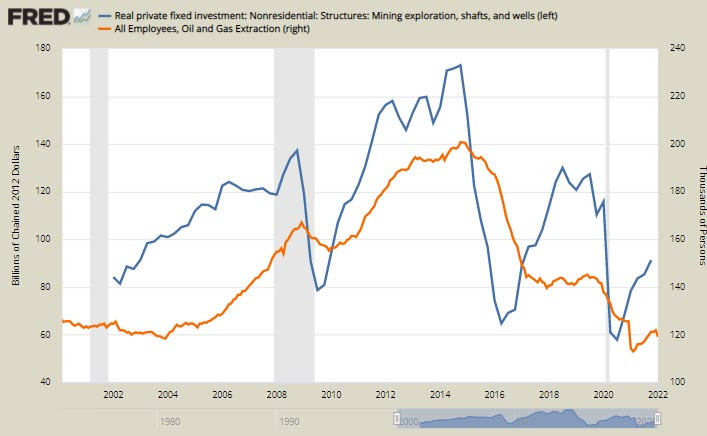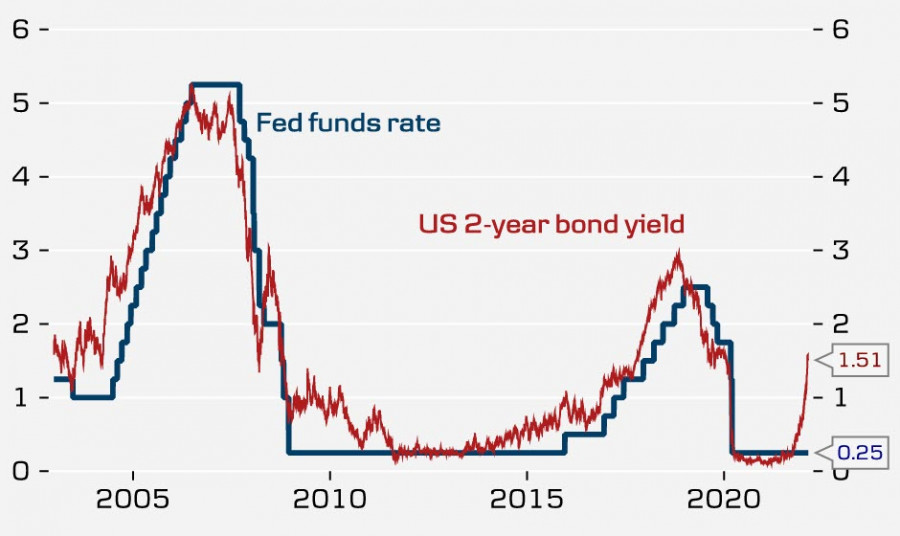
The United States continues to escalate tensions on the European continent, pursuing its goals, which are not yet completely clear. For some reason, the United States calls the invasion of Ukraine "inevitable", creating a false pretext for starting a war. Despite the absurdity of such plans, preparations for military operations are proceeding rapidly.
There might be no real preparation for war, but the markets do not react to reality, but informational noise. The S&P500 index lost more than 2% at the end of the day, the stock markets of the Asia-Pacific countries were in the red, and there is no doubt that Europe will also open in the red zone. Oil's growth is also largely due to geopolitical reasons. Meanwhile, US investments in the extractive sector are at low levels, and far from the 2015 high, employment is not growing, which means there is no potential for production growth in the short term.

The minutes of the Fed's January meeting, published on Wednesday, slightly lowered expectations of a rate hike in March by 0.5% at once, so it can be considered dovish. However, on the pace of the overall rate hike, Fed officials are preparing to do it more aggressively than previously predicted, due to higher inflation, a confident labor market, and stronger growth prospects. There is no unity in the comments of the Fed officials after the publication. In particular, the head of the St. Louis Fed Bullard confirmed the previously expressed position on the need to raise the rate by 100 points by July, while Kashkari is confident that raising the rate will not help reduce inflation. In turn, Harker calls for raising the rate in March by only 0.25%.
The publication of the latest data turned out to be generally softer, but did not cause a noticeable reaction of the market, which was under the spell of "preparing for war". The Philadelphia Fed index declined from 23.2p to 16.0p in February, which was below the 20p forecast. The initial unemployment claims rose unexpectedly from 225k to 248k instead of an expected decline to 218k. Weakness in regional reviews could potentially indicate that the ISM indices in February will also show a decline.
There is no consensus on the Fed's plans in the market, and this only adds to the tension. While the pace of the US economic recovery looks somewhat overvalued, financial indicators that require immediate intervention are off the scale. Analyzing the cycles of rate increases over the past 30 years, Danske Bank believes that the current conditions are already very different from what they were before – core inflation is much higher, unemployment is lower, yields are rising rapidly, and the rate lags behind them unreasonably far.
Accordingly, the bank said that the Fed will be forced to quickly catch up with the yield curve, and as a result, will raise the rate by 200 points this year, and start immediately from 50p in March. In May, it will begin to reduce the balance. If its calculations are correct, then we should expect a faster increase in the burden on the US budget and a rapid increase in the budget deficit, which will require decisive action from the government.
The United States needs to create conditions for the inflow of foreign capital, for which it is necessary to implement a combination of two factors – to create more favorable conditions for doing business and to prevent a rapid tightening of financial conditions due to the necessary actions of the Fed. The first is achieved by rising prices for raw materials and energy, which is why oil has good prospects for growth, despite the low level of investment in the sector, as well as natural gas prices in Europe. The second one is the growth of geopolitical tensions in Europe, which creates conditions for capital flight.
Therefore, we tend to regard the growth of geopolitical tensions in Europe as a cover operation for the inevitable start of the Fed's rate hike cycle in March. Its goal is to support the weakening US dollar and shift to the side of investors withdrawing their capital from Europe, the main risks of implementing the "Biden plan" before the midterm elections this fall when the Fed will begin to reduce the balance sheet and will not be able to finance the US budget in the same volumes. Without such massive support, the US dollar would have weakened much faster as the CFTC reports have shown for several weeks.